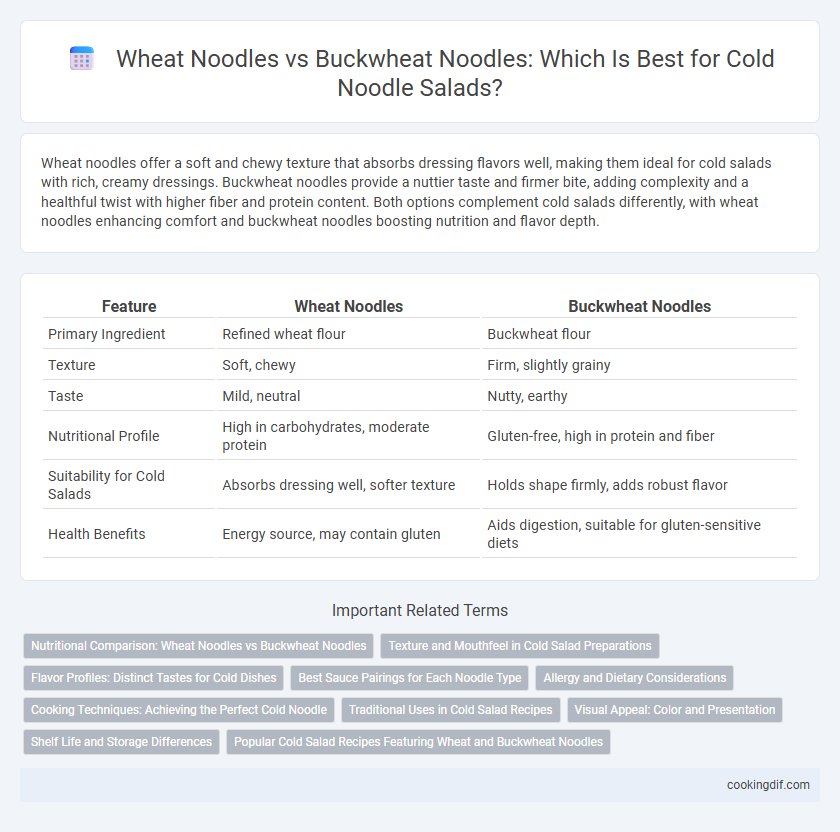Wheat noodles offer a soft and chewy texture that absorbs dressing flavors well, making them ideal for cold salads with rich, creamy dressings. Buckwheat noodles provide a nuttier taste and firmer bite, adding complexity and a healthful twist with higher fiber and protein content. Both options complement cold salads differently, with wheat noodles enhancing comfort and buckwheat noodles boosting nutrition and flavor depth.
Table of Comparison
| Feature | Wheat Noodles | Buckwheat Noodles |
|---|---|---|
| Primary Ingredient | Refined wheat flour | Buckwheat flour |
| Texture | Soft, chewy | Firm, slightly grainy |
| Taste | Mild, neutral | Nutty, earthy |
| Nutritional Profile | High in carbohydrates, moderate protein | Gluten-free, high in protein and fiber |
| Suitability for Cold Salads | Absorbs dressing well, softer texture | Holds shape firmly, adds robust flavor |
| Health Benefits | Energy source, may contain gluten | Aids digestion, suitable for gluten-sensitive diets |
Nutritional Comparison: Wheat Noodles vs Buckwheat Noodles
Wheat noodles provide a higher carbohydrate content, making them a quick energy source, while buckwheat noodles are richer in protein and essential amino acids, supporting muscle repair and growth. Buckwheat noodles also contain more fiber and antioxidants, contributing to better digestion and cardiovascular health. Both options offer unique nutritional benefits, but buckwheat noodles stand out for their gluten-free properties and lower glycemic index, ideal for cold salad preparations.
Texture and Mouthfeel in Cold Salad Preparations
Wheat noodles offer a smooth, slightly chewy texture that holds up well in cold salads, providing a pleasant bite that complements crisp vegetables. Buckwheat noodles, also known as soba, feature a firmer, nuttier mouthfeel, adding a distinct earthiness and a subtle graininess that enhances overall flavor complexity. Both types maintain their structural integrity when chilled, but wheat noodles' elasticity makes them more adaptable to varied dressings, while buckwheat noodles excel in dishes highlighting bold, savory flavors.
Flavor Profiles: Distinct Tastes for Cold Dishes
Wheat noodles offer a mild, slightly sweet flavor and chewy texture that absorbs dressings well, making them ideal for cold salads with fresh vegetables and light sauces. Buckwheat noodles, or soba, deliver a robust, nutty taste and firmer bite, complementing bold flavors and ingredients like sesame, soy sauce, and ginger. Choosing between wheat and buckwheat noodles depends on the desired flavor intensity and the dressing or toppings used in the cold salad.
Best Sauce Pairings for Each Noodle Type
Wheat noodles, with their soft texture and mild flavor, pair excellently with light, citrus-based sauces like yuzu vinaigrette or sesame soy dressing that enhance freshness in cold salads. Buckwheat noodles, known for their earthy taste and slightly chewy bite, complement richer, umami-forward sauces such as miso dressing or spicy peanut sauce, which balance their robust flavor profile. Selecting the right sauce amplifies the texture contrast and flavor depth unique to each noodle, elevating the cold salad experience.
Allergy and Dietary Considerations
Wheat noodles contain gluten, posing risks for individuals with celiac disease or gluten intolerance, while buckwheat noodles are naturally gluten-free, making them a safer option for allergic or sensitive consumers. Buckwheat noodles also offer higher protein and fiber content, supporting dietary preferences focused on nutrient density and digestive health. Choosing buckwheat noodles enhances cold salad recipes by providing a hypoallergenic and nutrient-rich base suitable for diverse dietary needs.
Cooking Techniques: Achieving the Perfect Cold Noodle
For cold salads, wheat noodles require boiling until just tender, then immediately rinsed under cold water to prevent overcooking and maintain a firm texture. Buckwheat noodles, or soba, benefit from a shorter cooking time and thorough rinsing with ice water to enhance their nutty flavor and achieve a springy bite. Proper draining and tossing with a light oil or dressing prevent sticking, ensuring an ideal texture for refreshing cold noodle salads.
Traditional Uses in Cold Salad Recipes
Wheat noodles, such as somen and thin ramen, are traditionally used in cold salads in East Asian cuisine due to their smooth texture and ability to absorb light dressings. Buckwheat noodles, known as soba, are prized for their nutty flavor and are often served chilled with dipping sauces in Japanese cold salad dishes. Both types of noodles offer distinct textures and flavors, making them staple ingredients in traditional cold noodle salads that emphasize refreshing, seasonal ingredients.
Visual Appeal: Color and Presentation
Wheat noodles offer a pale, creamy color that provides a neutral backdrop, enhancing the vibrancy of fresh vegetables and herbs in cold salads. Buckwheat noodles present a darker, earthy brown tone that creates a rustic, visually striking contrast with bright greens and vivid reds. Choosing wheat or buckwheat noodles impacts the overall color balance and presentation, catering to different aesthetic preferences in cold salad dishes.
Shelf Life and Storage Differences
Wheat noodles generally have a longer shelf life than buckwheat noodles due to their lower fat content, which reduces the risk of rancidity during storage. Buckwheat noodles should be stored in an airtight container in a cool, dry place or refrigerated to maintain freshness, while wheat noodles are more tolerant to room temperature storage. Proper storage conditions for both types help preserve texture and flavor, but wheat noodles offer greater convenience for extended storage in cold salad preparations.
Popular Cold Salad Recipes Featuring Wheat and Buckwheat Noodles
Wheat noodles offer a chewy texture and neutral flavor that pairs well with vibrant vegetables and tangy dressings in cold salads like classic Asian soba salads and Mediterranean pasta salads. Buckwheat noodles, rich in antioxidants and gluten-free, provide a nutty taste that complements ingredients such as sesame seeds, scallions, and soy-based sauces, popular in Japanese and Korean cold noodle dishes. Both noodle types enhance cold salads by balancing nutrition and flavor, making them staples in diverse culinary traditions worldwide.
Wheat noodles vs buckwheat noodles for cold salads Infographic

 cookingdif.com
cookingdif.com